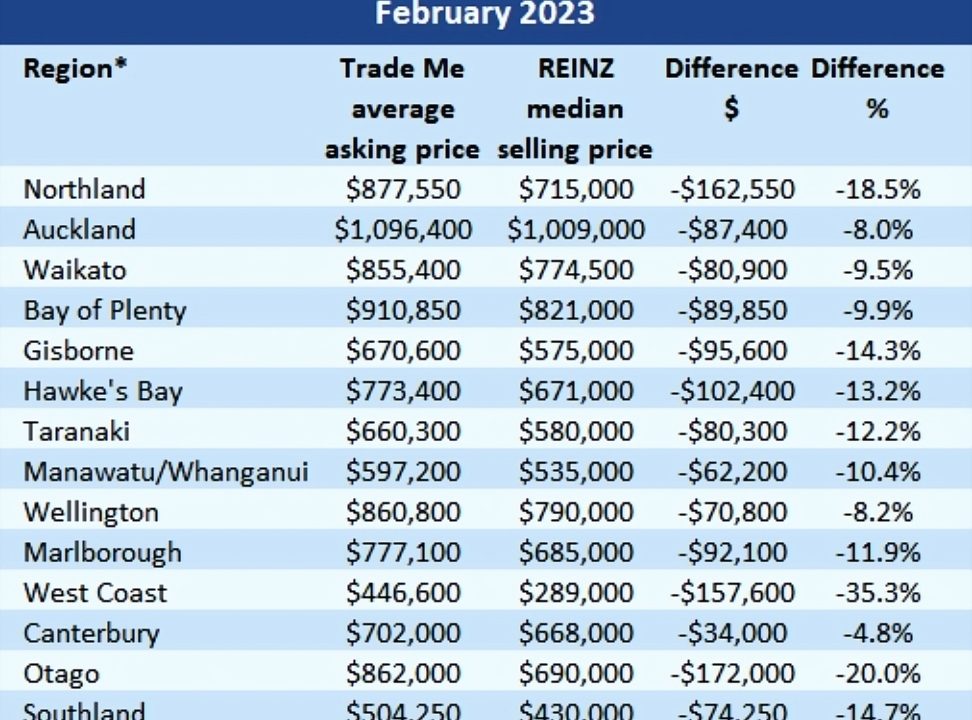
Latest figures suggest homes are selling for around $100,000 less than their asking price
호가보다 $10만불 정도 낮게 팔리는 부동산 추세
Residential properties appear to be selling for around $100,000 less than their asking prices, with vendors being slow to accept how much values have fallen and buyers driving hard bargains.
최신 자료에 따르면 주택들이 호가보다 약 10만불 정도 낮은 가격으로 팔리고 있는데, 이는 매도인들이 가치가 하락한 정도를 느리게 받아들이고 있는데 반해, 구매자들은 적극적으로 흥정을 벌이는 상황이기 때문인 것으로 나타났다.
Comparing the average asking prices on Trade Me Property with the Real Estate Institute of NZ’s median selling prices, shows on average there is a huge gap between the prices vendors are hoping for and the prices buyers are prepared to pay.
Trade Me Property에서 평균 호가와 NZ 부동산 협회의 실거래가의 중간값을 비교해 본 결과, 매도인들이 바라는 가격과 구매자들이 지불할 의사가 있는 가격 사이에는 평균적으로 큰 격차가 있음을 보여주고 있다.
In February, the national average asking price of properties advertised on Trade Me was $870,550, while the national median selling price recorded by the REINZ in the same month was $762,000, a discount of $108,550 to the average asking price.
2월에는 Trade Me에서 광고된 부동산의 전국 평균 호가가 $870,550달러 였고, 같은 달 REINZ에서 기록한 전국 실거래 중간값은 $762,000달러로 이는 평균 호가에서 약 $108,550달러가 떨어진 것이다.
The same phenomenon was evident throughout the country, with selling prices substantially lower than asking prices in all regions.
The biggest difference between the two figures was $172,000 in Dunedin. Canterbury had the smallest difference at $34,000.
같은 현상은 전국적으로 두드러지게 나타나며, 모든 지역에서 실거래가가 호가보다 낮았다. 두 가격 사이의 큰 격차는 Dunedin에서 $172,000달러였고, Canterbury는 $34,000달러로 가장 작은 차이를 보였다.
Prices suggests many, if not most, vendors have not fully accepted how much the housing market has changed over the last 12 months and have unrealistic price expectations when they list their properties for sale.
호가와실거래가 사이의 격차 크기는, 많은 매도인들이 지난 12개월간주택 시장이 얼마나 변했는지 완전히 받아들이지 못하고 자신들의 부동산을 매도할 때 비현실적인 가격 기대를 가지고 있다는 것을 시사한다.
The size of the gap between asking and selling prices have also been falling faster than asking prices, with the REINZ’s median selling price down 13.9% in the year to February, while Trade Me’s average asking price was down 9.2% over the same period.
실거래가와 호가의 차액 정도는 실거래가보다 빠르게 줄어들고 있으며, 2월까지의 1년간 REINZ의 실거래가 중간값은 13.9% 하락했고, 같은 기간에 Trade Me의 평균 호가는 9.2% 하락한 것으로 나타났다.
That also suggests vendors have been slower to adjust their expectations to the changing market than buyers.
이는 매도인들의 변하는 시장에 따른 기대를 구매자들보다늦게 받아들이고 있음을 보여준다.
That’s likely to be one of the main reasons the market has been so slow, with residential sales down 31% in February compared to the same month last year, while the number of homes available for sale was up 25% compared to a year ago.
2월 주택 가격이 작년 같은 달에 비해 31% 감소한 반면, 시장에 나온 주택 매물수는 1년 전에 비해 25% 증가하는 상황이 시장의 속도가 느린 주된 이유 중 하나일 가능성이 높다.
Although the Trade Me and REINZ figures are calculated differently, with Trade Me providing an average price and the REINZ a median price, the difference this creates is unlikely to be huge.
Trade Me와 REINZ 수치는 다르게 계산됨에도 불구하고, Trade Me는 평균 가격을 제공하고 REINZ는 중간값을 제공하므로 이로 인해 발생하는 차이는 크지 않을 것이다.
The chart below shows the difference between asking and selling prices throughout the country, and although it is not an exact measurement, it probably gives a reasonably good idea of what is happening in the market.
아래차트는 전국의 호가와 실거래가와 차이를 보여준다. 정확한 수치는 아니지만 현재 일어나고 있는 시장상황을 합리적으로 파악할 수 있다.
As the peak summer selling season is drawing to a close and economic uncertainties show no sign of abating, vendors hoping to achieve a sale over the next few months are probably going to have to bite the bullet on price in what is likely to be a painful exercise for many.
여름 매매 성수기가 끝나가고 경제적 불확실성이 완화될 기미가 보이지 않는 가운데, 향후 몇 개월 동안 매도를 하고자 하는 주택 소유주들은 아마도 조금은 고통스러울 수 있는 가격을 감수해야 할 것으로 예상된다.

